Denmark's Fourth National Communication on Climate Change
2. National circumstances relevant to greenhouse gas emissions and removals
The Kingdom of Denmark comprises Denmark, Greenland and the Faroe Islands. The UN Framework Convention on Climate Changes has been ratified on behalf of all three parts of the Realm. Therefore, this report includes information about Denmark, Greenland and the Faroe Islands. However, at the present time, more information is available on Denmark than on the other parts of the Realm. Where tables, figures, and other information in this report also cover Greenland and/or the Faroe Islands, this is stated.
2.1 DENMARK
2.1.1 Form of government and structure of administration
Denmark is a constitutional monarchy, and the power of the state is divided between the legislative branch, the executive branch, and the judicial branch. According to the Constitution of the Realm, legislative power lies with the Folketing, which consists of 179 members, two of whom are elected on the Faroe Islands and two in Greenland. The members are elected by the population for a period of normally four years. A new general election can mean that a member sits for less than this period.
The executive branch - the government - cannot have a majority of the Folketing against it, cf. the regulations in the Danish Constitution on votes of no confidence. Since 1953, Denmark has often had a minority government, i.e. a government supported by a minority of the members of the Folketing. In these situations the government will need to include a support party.
The number of ministers in the government varies. Since 1971 Denmark has had a Minister for the Environment and a Ministry of the Environment who represent Denmark in international negotiations on climate and which also have primary responsibility for coordination and implementation of legislation, plans etc. for the climate area.
For the last ten years or so, other ministries have also worked with environmental and climate issues. In 1988 the government decided to follow up the UN report on sustainable development, the Brundtland report, in which one of the main messages was the necessity of integrating the environmental issue into the administration within sectors such as transport, agriculture, and energy.
For this reason, a number of sector ministries have drawn up action plans in which the environment is an integral element. Examples are sector plans for energy, transport, agriculture, and development assistance. In the climate area, further to the previous government's status report Climate 2012 from 2000, the government presented an overall status in connection with the presentation of its proposal for ratification of the Kyoto Protocol in April 2002. This status report was followed in February 2003 by a government proposal for a national Climate Strategy for Denmark, including analyses from the sector ministries, which was adopted by the Folketing on 13 March 2003.
One of the main cornerstones of Danish democracy is autonomous local government. The specific environmental action takes place not only at national level but also at county and municipal level. The state sets the national rules and framework for environmental administration, while the counties and municipalities, working within this framework, plan and decide initiatives that implement and support the national legislation.
The importance of local involvement is stressed in Agenda 21 - a global agenda for sustainable development in the 21st century, which was adopted at the Rio Conference in 1992. The government supports the popular interest and participation in climate and environmental issues in different ways - including through implementation of the Pan-European Aarhus Convention and support for the local Agenda 21 work initiated by most of the Danish municipalities.
2.1.2 Population
Today, Denmark has a population of slightly more than 5.4 mill. As will be seen from Table 2.1, population growth has been relatively small in the last 24 years.
TABLE 2.1 POPULATION OF DENMARK
Source: Statistics Denmark.
| 1980 | 1990 | 2004 | |
| Denmark's population (in mill.) | 5.1 | 5.1 | 5.4 |
The latest forecasts show that population growth will continue to be moderate in the years ahead. For example, the population is expected to reach 5.46 mill. in 2010, rising to 5.53 mill. in 2025. The low birth rate in the 1980s means that young people between the ages of 15 and 24 years make up only 11% of the population, while the elderly, between 50 and 64 years of age, account for 20%.
Today, the population density is 125 per km².
Today, 75% of Danish wage earners are employed in service trades, while 18% are employed in manufacturing.
2.1.3 Geography
Denmark consists of the Jutland peninsula and more than 400 islands. It has a total area of 43,098 km² and lies at about 55° N and 11° E.
The whole of the country is lowland. The surface was formed by Ice Age glaciers and glacial streams. The highest hill is approximately 170 metres above sea level.
The coastline has a length of more than 7,300 km. To protect low-lying land against flooding and storm surge, it has been necessary to build dikes or other permanent installations along about 1,800 km of coastline. In addition, sandbags, breakwaters and similar protect other parts of the coastline, which would otherwise erode because they consist of soft materials deposited during the last Ice Age.
A rise in the water level due to climate change would obviously affect the protection of the coasts and create a greater risk of flooding and erosion.
The Danish landscape is indelibly stamped by the high population density. More than 66% of the land is used for agriculture or horticulture. Woodlands take up 11%, while towns, roads and scattered habitation take up 10%. The rest is nature or listed areas such as lakes, watercourses, heaths, dunes and beaches.
In relation to its size, Denmark is home to a wide variety of flora and fauna - in all, about 30,000 species.
2.1.4 Climate
The Danish climate is temperate with precipitation evenly distributed over the year. The country lies in the zone of prevailing westerly winds, which is characterised by fronts, low pressure, and changeable weather. Compared with other regions on the same latitude as Denmark, the climate is relatively warm due to the warm North Atlantic current that originates in the tropical sea off the east coast of the USA.
Denmark has a distinctly coastal climate, with mild, damp winters and cool, unsettled summers. Average temperatures vary from about half a degree in winter to about 15 degrees in summer. However, the weather in Denmark is greatly affected by the proximity of both the sea and the continent. This means that the weather can change, depending on the prevailing wind direction. The west wind from the sea brings relatively uniform weather in summer and winter: mild in winter and cool in summer. When the wind comes from south or east, the weather in Denmark is more similar to that of the continent: warm and sunny in summer and cold in winter. The weather in Denmark thus depends very much on the wind direction and the season.
Atmospheric pressure
Average atmospheric pressure in Denmark shows seasonal variation, reaching a minimum in November and a maximum in May.
Denmark's highest-ever atmospheric pressure, 1062.5 hPa, was recorded in Skagen on 23 January 1907, while just one month later, on 20 February, the lowest atmospheric pressure in the history of Denmark was also recorded in Skagen, at 943.9 hPa.
Temperature
The annual mean temperature varies from year to year, from below 6°C to more than 9°C, with an average of 7.7°C. The coldest year so far was 1879, with a mean temperature of 5.9°C, while the hottest recorded year was 1990, with 9.3°C. Since 1988, almost every year has been hotter than normal, and the temperature showed a sharply rising trend in the 1990s. Over the last 125 years, the temperature in Denmark has risen by almost 1.5°C, but the ten hottest years occurred from the 1930s to the 1990s.
FIGURE 2.1 ANNUAL MEAN TEMPERATURE IN DENMARK 1873-2004 IN °C
Source: Danish Meteorological Institute
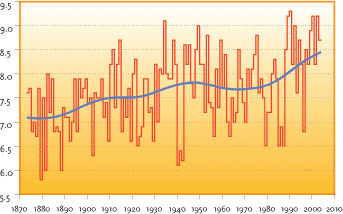
FIGURE 2.2 DANISH ANNUAL PRECIPITATION 1874-2004 IN MM
Source: Danish Meteorological Institute
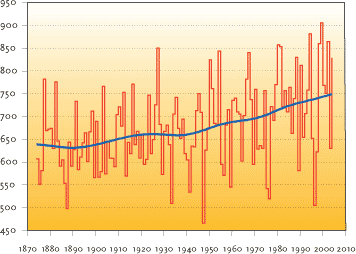
FIGURE 2.3 ANNUAL HOURS OF SUNSHINE IN DENMARK 1920-2004
Source: Danish Meteorological Institute
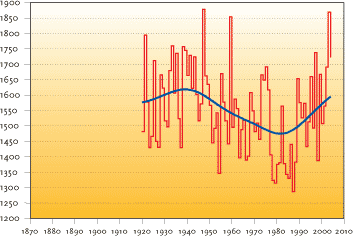
FIGURE 2.4 ANNUAL MEAN CLOUD COVER IN DENMARK 1874-2004 IN PERCENT
Source: Danish Meteorological Institute
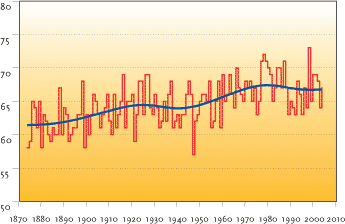
The temperature in January and February averages around 0°C but can vary greatly from 12°C to below -31°C. The average temperature in July and August is around 15°C, but again can vary from below -3°C to more than 36°C.
Precipitation
Average annual precipitation varies greatly from year to year and from place to place. The lowest annual precipitation for the country as a whole was 464 mm in 1947, and the highest was 905 mm in 1999, while the average annual precipitation is 712 mm.
The wettest months are normally September, October, and November, while the driest are February to May.
In the winter months, precipitation is sometimes in the form of snow. Annual precipitation in Denmark has on average increased by about 80 mm since 1870.
Hours of sunshine and cloud cover
On average, Denmark as a whole has about 1,495 hours of sunshine annually, but this figure varies greatly from year to year. The sunniest year was 1947, with 1,878 hours, and the least sunny was 1987, with 1,287 hours. There is least sunshine in January and December with slightly more than 40 hours in most places, while May and June have the most sunshine with an average of about 210 hours.
Average annual cloud cover is 65%. 129 days are cloudy, i.e. with cloud cover at >80% and only 27 days are clear, with cloud cover at <20%.
Since 1980, the trend has been towards more hours of sunshine and less cloud cover.
Wind
Countrywide, annual mean wind velocity is 5.8 m/s, and the wind is most frequently from westerly directions, from which about 25% of all winds come.
The number of days with severe wind (r 10.8 m/s) varies from about 30 in some places inland to almost 170 days at Skagen. On average, storm-force (r 24.5 m/s) occurs along the Danish coasts every three to four years. In December 1999 large parts of Denmark were hit by the worst-ever measured hurricane, and in some places mean wind velocities (average over 10 minutes) of more than 40 m/s were recorded, with gusts of more than 50 m/s.
2.1.5 Economy
Since 1993 economic growth in Denmark has been considerable, with GDP (Gross Domestic Product) rising at an average of 2.7% per year. In 2003, GDP was DKK 1,400 billion, corresponding to DKK 260,000 per capita (1 Euro = DKK 7.45).
In 2003 the public debt stood at 7% of GDP, compared with 78% in 1993. In the same period, foreign debt was reduced from 32% of GDP in 1993 to 15% GDP in 2003.
From Table 2.2, which shows key figures for the Danish economy, it will be seen that Denmark has a very open - and thus sensitive economy, in which export accounts for a substantial part of total demand. In addition, public expenditure accounts for a large part of GDP. Table 2.3 shows the business sector's contribution to GDP.
TABLE 2.2 KEY FIGURES FOR THE DANISH ECONOMY. CURRENT PRICES, 2003, IN DKK MILL.
Source: Statistics Denmark.
| GDP | 1,396,806 |
| Imports | 508,741 |
| Exports | 594,837 |
| Consumer spending | 659,259 |
| Public expenditure | 371,839 |
| Gross investment | 280,440 |
| Public debt asa%ofGDP | 6.9% |
| Foreign debt asa%ofGDP | 15.0% |
2.1.6 Energy
Energy production and energy-consuming activities are the main contributors to the emissions of greenhouse gases in Denmark. The energy sector alone (energy production and supply) accounts for 44% of Denmark's total emissions of greenhouse gases, primarily CO2. In addition there are emissions from the energy-consuming activities in the transport sector, industry and households.
In the energy sector, CO2 emissions have been reduced despite strong economic growth. This was achieved through long-term ambitious efforts, which must be followed up and developed further in order to maintain the positive trend.
TABLE 2.3 THE BUSINESS SECTOR'S CONTRIBUTION TO GDP, CURRENT PRICES 2003, IN DKK MILL
Source: Statistics Denmark.
| Sector | Gross increase in value | % |
| Agriculture, etc., mining | 60,063 | 5.0 |
| Industry, including energy and building | 279,663 | 23.3 |
| Services | 902,167 | 75.3 |
| Indirectly measured financial services | -43,847 | -3.6 |
| Gross Domestic Product | 1,198,046 | 100 |
Production and supply
As will be seen from Table 2.4, Denmark's own production of energy has grown almost 30-fold since 1980 and it almost more than tripled since 1990. Denmark is self-sufficient in energy, see Table 2.5. This is mainly due to the production of oil and gas in the North Sea, but renewable energy is also increasingly contributing to the country's energy supply.
Today, 13.6% of the actual consumption of energy is supplied by renewable energy. The renewable energy resources are mainly wind energy and biomass, which are used to produce electricity, combined heat and power, or district heating.
TABLE 2.4 ENERGY PRODUCTION (PJ)
Source: Danish Energy Authority
| 1980 | 1990 | 1995 | 2000 | 2001 | 2002 | 2003 | |
| Production, total | 40 | 423 | 656 | 1164 | 1138 | 1202 | 1194 |
| Crude oil | 13 | 254 | 392 | 765 | 726 | 780 | 780 |
| Natural gas | 0 | 116 | 197 | 310 | 318 | 318 | 302 |
| Renewable energy etc. | 28 | 53 | 67 | 89 | 95 | 103 | 112 |
TABLE 2.5 DEGREE OF SELF-SUFFICIENCY (%)
Source: Danish Energy Authority
| 1980 | 1990 | 1995 | 2000 | 2001 | 2002 | 2003 | |
| Energy, total | 5 | 52 | 78 | 139 | 136 | 145 | 144 |
| Oil | 2 | 71 | 105 | 204 | 194 | 217 | 228 |
| Oil and natural gas | 2 | 84 | 116 | 189 | 183 | 197 | 203 |
Internationally, Denmark is among the leading nations in wind energy.
Energy consumption
Despite the economic growth, total energy consumption has remained largely unchanged at approximately 800 PJ since 1980, cf. Tables 2.6 and 2.7.
Denmark's dependence on oil and coal has fallen. Particularly in the production of electricity and heat, oil and coal have been substituted with other fuels. Thus, natural gas, waste and biomass are increasingly being used in small-scale and industrial CHP plants, natural gas and renewable energy is increasingly being used in large scale electricity production, and natural gas is increasingly being used for individual heating of buildings.
The distribution of gross energy consumption (energy consumption adjusted for foreign electricity trade) in 2003 was as follows: industry and agriculture accounted for 26%, domestic sector for 27%, transport for 25% and commerce and service for 15%. Refining and non-energy purposes accounted for the remaining 7%
TABLE 2.6 ACTUAL ENERGY CONSUMPTION (PJ)
Source: Danish Energy Authority
| 1980 | 1990 | 1995 | 2000 | 2001 | 2002 | 2003 | |
| Energy consumption, total | 830 | 752 | 840 | 812 | 832 | 822 | 863 |
| Oil | 555 | 343 | 371 | 367 | 368 | 354 | 343 |
| Natural gas | 0 | 76 | 133 | 186 | 194 | 194 | 195 |
| Coal | 252 | 255 | 272 | 165 | 174 | 175 | 238 |
| Renewable energy etc. | 28 | 53 | 67 | 92 | 98 | 106 | 117 |
| Net imports of electricity | -4 | 25 | -3 | 2 | -2 | -7 | -31 |
TABLE 2.7 GROSS ENERGY CONSUMPTION, BREAKDOWN BY FUELS, ADJUSTED FOR CLIMATE FLUCTUATIONS AND NET EXPORTS (PJ)
Source: Danish Energy Authority
| 1980 | 1990 | 1995 | 2000 | 2001 | 2002 | 2003 | |
| Gross energy consumption, total | 816 | 820 | 839 | 837 | 834 | 827 | 829 |
| Oil | 548 | 356 | 373 | 375 | 375 | 360 | 343 |
| Natural gas | 0 | 83 | 134 | 193 | 194 | 197 | 191 |
| Coal | 241 | 326 | 265 | 176 | 167 | 162 | 176 |
| Renewable energy etc. | 27 | 55 | 68 | 94 | 98 | 108 | 118 |
Figure 2.5 shows adjusted energy consumption, sector by sector. Over the last 23 years relative consumption by the transport sector has risen, whereas relative domestic sector consumption has fallen.
Structure of the market
The structure of the market in the energy sector is characterised by a division between production and supply of natural gas and oil, electricity, and district heating.
FIGURE 2.5 ADJUSTED GROSS ENERGY CONSUMPTION, BREAKDOWN BY SECTOR
Source: Danish Energy Authority
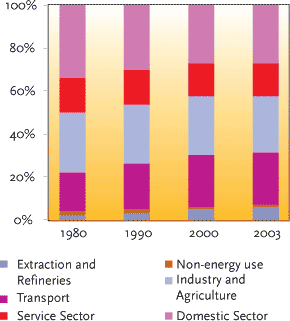
Most production of natural gas and oil is taken care of by a private company, DUC (Dansk Undergrunds Consortium), while the state-owned company DONG (Dansk Olie og Naturgas) takes care of the transportation of natural gas from the fields in the North Sea to the shore. At the DONG treatment plant at Nybro, the gas is treated and then sent on in the natural gas system to customers. Gastra, a subsidiary of the 100% state-owned company Energinet.dk, owns and operates the transmission grid for natural gas. The distribution grids in southern Jutland and western and southern Zealand are owned and operated by DONG, while the distribution grids in northern and mid Jutland, on Funen and in the Copenhagen region are owned and operated by municipal associations. In addition there are two natural gas storage facilities which are owned and operated by DONG. In connection with implementation of the EU gas directive, there has been liberalisation in the gas sector which means, for example, that since 1 January 2004 all gas customers have had full access to the market.
In connection with the implementation of the EU Directive on liberalisation of the electricity sector, a reform of this sector has also been carried out. This reform means full market opening and all electricity consumers have a free choice of electricity supplier. More than 2/3 of the electricity supply comes from large primary power stations or CHP plants.
Approximately half of the demand for heating is supplied by district heating. The heat is supplied from primary and small-scale CHP plants, waste incineration plants and biomass-fired district heating stations. Apart from the primary plants, the plants are owned either by municipalities or by local cooperatives that are owned by the consumers. Initially, district heating will not be covered by the liberalisation process, but the government will investigate whether it is possible in the longer term to have a more free choice of supplier in areas with large, interconnected district heating grids.
Energy policy agreements of 29 March 2004
On 29 March 2004 the government entered into a number of energy policy agreements with a broad majority of the Folketing parties and with the organisation representing electricity grid companies, Elfor. The main points described in the following text box reflects the agreements established in a new overall framework for the market structure and ownership of the energy sector.
• Separation of ownership of overall electricity and gas transmission from commercial activities
Key elements of the agreement are that electricity grid companies transfer responsibility for system operation and the overall transmission net to the state with a view to separating ownership of the overall infrastructure from commercial activities relating to trading and electricity production. Owner shares in the overall electricity transmission network are taken over by the newly established state company Energinet.dk, and responsibility for system operation is transported to the company from Elkraft System and Eltra. As regards natural gas, the state company DONG has transferred its subsidiary Gastra to Energinet.dk, so that in the future the company will own and operate systems, electricity transmission and natural gas transmission in Denmark. This separation of ownership of the overall net from commercial activities relating to electricity and gas, provides an important basis for efficient competition in the Danish energy sector.
• Changes in the ownership structure in the energy sector
As part of the energy policy agreements and the agreement with Elfor, the provisions of the Electricity Supply Act on distinction between free and tied-up capital were repealed, thus providing an incentive to reorganise companies and adapting the structure in the electricity sector. The result has been that a number of grid companies and municipalities in Jutland and on Funen have relinquished their interests in Elsam. The remaining municipalities and grid companies who are shareholders have also disposed of their holdings. On 10 December the Minister for Finance and the boards of Elsam A/S and DONG A/S made an agreement on merging Elsam and DONG. In east Denmark, in spring 2004 Elsam took over the majority of the shares in NESA A/S, including the ownership interest in Energi E2, while SEAS, NVE and a number of municipalities, including Copenhagen City entered into agreements with DONG A/S on their shares in the production enterprise Energi E2. The agreements with SEAS and NVE as well as Copenhagen City allow for either cash payment, or settlement with shares.
Moreover, the DONG A/S agreements with Copenhagen City and the City of Frederiksberg include that DONG A/S is to take over Københavns Energi and Frederiksberg Forsyning.
The framework agreement of 10 December 2004 and the DONG A/S agreements mean there is the prospect of forming a large Danish energy company which will be able to compete with the even larger foreign energy companies and act as a dynamo for strong commercial and technological development of the energy area in Denmark. However, it is still uncertain when the merger between DONG and Elsam can be implemented. The new company must be examined by the competition authorities. With the agreement of 1 June 2005 between DONG, Elsam, Energi E2 and Vattenfall on power plants and shares, ownership in the Danish power plant sector has changed considerably. Under the agreement, Vattenfall takes over three large power plants – Nordjyllandsværket, Fynsværket and Amagerværket – and the decentral CPH plants at Helsingør and Hillerød. It also takes over a portfolio of wind turbine activities. In all, Vattenfall takes over production activities totalling approx. 2,400 MW. DONG takes over Vattenfall's 35.3 per cent owner shares in Elsam and the 40 per cent Vattenfall owner share in the power plant Avedøre2. Elsam and Energi E2 retain production activities totalling approx. 7,300 MW.
With this agreement, and assuming approval by the competition authorities, the establishment of a new powerful energy company in Denmark is ensured through a merger of DONG, Elsam, Energi E2, NESA, Københavs Energi (el) and Frederiksberg Forsyning.
• Price regulation of grid companies
With the new statutory order, revenue framework regulation of electricity grid companies changed from regulation of costs to regulation of income. The new regulations encourage enterprises to promote efficient operation, as through this they can improve their business. Consumers are protected against increases in net charges as they must not exceed the level at 1 January 2004 (calculated at fixed prices). As from 2008 the companies must meet a number of efficiency requirements based on benchmarking. Similarly, a revenue framework order has been issued for the natural gas distribution companies, providing for incentives to the companies to promote the efficiency in operations.
• Expansion of wind turbines
A significant element in the agreements of 29 March 2004 was the agreement on the basis for further expansion of wind turbine capacity. It was agreed to establish two offshore wind farms, each of 200 MW. It was decided to situate the farms at Horns Rev and Rødsand. The two wind farms will be established on the basis of a negotiated procedure. A prequalification of interested investors will be carried out before tenders are issued and negotiations commence. The decisive criterion in the procedure is the price per kWh, which the tenderer requires for completing the project.
Energi E2 won the tender for a 200 MW offshore wind park at Horns Rev. The Energy E2 bid was based on the lowest settlement price, fixed at DKK 51.8/kWh for 50,000 full capacity hours, corresponding to approx. 12 years of electricity production. It has been agreed to put the park in operation in the course of 2009. The Danish Energy Authority has received four applications from companies wishing to take part in the tender at Rødsand. The Danish Energy Authority expects in the course of autumn 2005 to select the companies that will be prequalified to take part in the tender.
From 1 January 2005 a new scrapping scheme has been introduced for older, poorly sited wind turbines onshore. The scheme aims at establishing new capacity of up to 350 MW over the next 5 years, but with far fewer turbines, and turbines with a total capacity of 175 MW will be dismantled. The subsidy for scrapping is DKK 0.12 per kWh for 12,000 full capacity hours. As one of the most important aspects of the scheme is the designation of areas to erect replacements for the scrapped turbines, the Energy Authority and the Danish Forest and Nature Agency are in a continuing dialogue with the regional planning authorities to secure sites for all the new wind turbines. Current estimates of gross areas for wind turbines are approx. 478 MW total capacity.
• Market orientation of small-scale heat and power plants
Following the agreements of 29 March 2004, small-scale heat and power production and other mandatory electricity are now based on market forces. Decentral plants have been given an incentive to organise electricity production on the basis of the prices of electricity on the market, because subsidies are now granted as financial, subsidies, independent of production, while electricity production is settled at the market price. This reorganisation is being introduced stepwise, so that plants above 10 MW operate under the new terms as from 1 January 2005, and plants between 5 and 10 MW do so no later than 1 January 2007. Small plants below 5 MW may remain under the old scheme indefinitely.
In order to achieve a better functioning electricity market, the regulations on mandatory electricity production were also repealed as from 1 January 2005. All electricity produced is now sold on the electricity market, and consumers can buy their entire consumption on market terms.
The 29 March agreement also means that the plants must not change from taxed fuels to tax-free fuels as yet. Therefore, from December 2004 regulations were introduced which mean that new application of biomass is only allowed in special circumstances.
Prices and taxes
Energy prices are one of the key factors governing energy consumption. In 2003 total spending on energy, including taxes and VAT, amounted to DKK 117.2 billion. Of this figure, domestic users paid DKK 57.8 billion, manufacturing industries DKK 26.1 billion, and the commercial sector and the service industries, including public services, DKK 27.8 billion. As a general rule, enterprises subsequently receive a full refund of energy taxes and VAT, but not of CO2 taxes.
Figures 2.6 and 2.7 show the energy prices paid by domestic users. Figure 2.6 shows the current consumer prices, including taxes and VAT. Figure 2.7 shows the development in fixed 2003 prices. The fixed prices have been adjusted for the change in general prices according to the consumer price index.
The prices of heating oil and natural gas follow each other because this is laid down by law. The tax on petrol has risen over time, and this has affected the price of petrol.
Measured in fixed prices, the prices of petrol, heating oil and natural gas fell from 1980 until the early 1990s, cf. Figure 2.7. The price of electricity increased slightly over the period.
As an added incentive to enterprises to improve their energy efficiency and reduce Danish emissions of CO2, a green tax package with gradually increasing taxes on CO2 and SO2 emissions as well as energy taxes was introduced in 1996. Enterprises with particularly high energy consumption can contract with the Danish Energy Authority on energy-efficiency improvements in return for a discount in the CO2 taxes and possibly heating taxes. Denmark wants CO2 taxes on the allowance-regulated fuel consumption for industrial production processes to be repaid as far as possible, and preferably in fully. Therefore Denmark will change the CO2 Taxes Act within the scope defined in the directive on energy taxation. The European Commission must approve the amendment, for instance under the rules on state subsidies.
FIGURE 2.6 ENERGY PRICES FOR DOMESTIC USERS IN CURRENT PRICES, DKK
Source: Danish Energy Authority
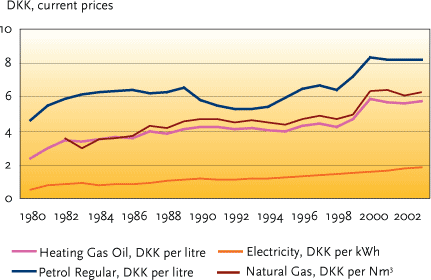
FIGURE 2.7 ENERGY PRICES FOR DOMESTIC USERS IN FIXED 2003 PRICES, DKK
Source: Danish Energy Authority
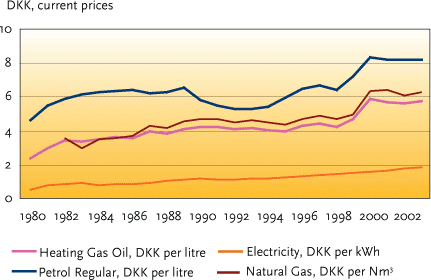
FIGURE 2.8 REVENUES FROM ENERGY, CO2 AND SULPHUR TAXES. CURRENT PRICES IN BILLION DKK
Source: Danish Energy Authority
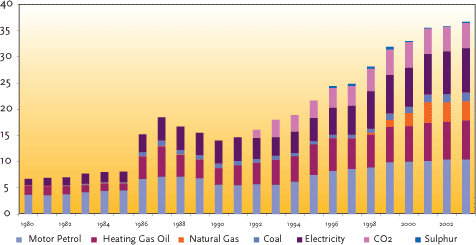
In 2003 the revenue from energy taxes amounted to DKK 36.7 billion, up from DKK 35.8 billion in 2002. The largest contribution, DKK 10.4 billion, comes from petrol. Total revenue has increased by 163% in relation to 1990, when there were no CO2 and sulphur taxes. In 2003 energy taxes accounted for more than 5.3% of total tax revenue.
TABLE 2.8 IMPORTS AND EXPORTS OF ENERGY
Source: Danish Energy Authority
| Imports | |||||||
| 1980 | 1990 | 1995 | 2000 | 2001 | 2002 | 2003 | |
| Crude oil, PJ | 259 | 174 | 229 | 159 | 131 | 140 | 150 |
| Oil products, PJ | 363 | 183 | 205 | 256 | 250 | 215 | 204 |
| Coal, PJ | 185 | 262 | 321 | 161 | 174 | 159 | 237 |
| Natural gas, PJ | 0 | 0 | 0 | 0 | 0 | 0 | 0 |
| Electricity, Gwh | 1979 | 11973 | 4013 | 8417 | 8199 | 8939 | 7023 |
| Exports | |||||||
| 1980 | 1990 | 1995 | 2000 | 2001 | 2002 | 2003 | |
| Crude oil, PJ | 2 | 118 | 203 | 203 | 513 | 590 | 574 |
| Oil products, PJ | 82 | 126 | 183 | 195 | 166 | 160 | 170 |
| Coal, PJ | 0 | 0 | 1 | 3 | 4 | 4 | 4 |
| Natural gas, PJ | 0 | 39 | 63 | 121 | 128 | 125 | 109 |
| Electricity, Gwh | 3216 | 4925 | 4807 | 7752 | 8775 | 11010 | 15568 |
Trade
In 2003, net foreign exchange earnings from energy products amounted to DKK 13.9 billion. There was a surplus on foreign trade in oil, natural gas, and electricity, but a deficit on foreign trade in coal.
2.1.7 Domestic sector
Figure 2.9 illustrates the changes in energy consumption for heating in Danish households. The Figure shows both development in final energy consumption and the changes in net heating consumption. Net heating consumption is the heating used after losses in boilers and heating installations, and it is the best measurement of actual heating consumption.
As can be seen, energy consumption for heating dropped significantly from the late 1970s to the early 1980s, primarily because of the oil crisis and subsequent initiatives in the early 1980s to insulate buildings.
Since the start of the 1990s the absolute final energy consumption for heating has been roughly constant, implying a drop in consumption per m². This is due to considerable conversion from oil to district heating. Net heat demand per m² has also been roughly stable throughout the 1990s. As newly built houses have had lower energy consumption, this means there has been a slight increase in the heating consumption per m² of existing buildings.
FIGURE 2.9 CHANGES IN DOMESTIC ENERGY CONSUMPTION FOR HEATING COMPARED WITH THE AREA HEATED
Source: Danish Energy Authority. Energy Statistics 2003
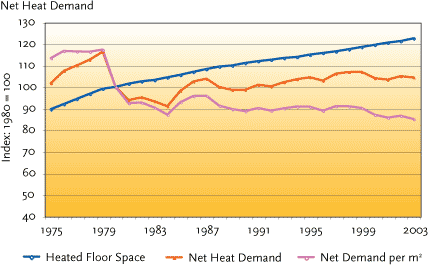
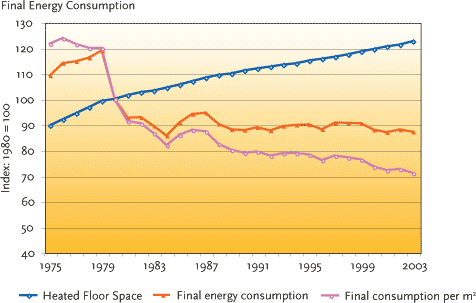
Figure 2.10 shows the changes in electricity consumption by domestic appliances and lighting (excluding electric heating). Electricity consumption has increased since 1975 and relatively parallel with the increase in private consumption. On average, the increase has been 1.8% per year, but somewhat lower in recent years; in the period 1990-2003 only 1% per year.
FIGURE 2.10 CHANGES IN DOMESTIC ELECTRICITY CONSUMPTION FOR APPLIANCES ETC., EXCL. ELECTRIC HEATING
Source: Danish Energy Authority. Energy Statistics 2003
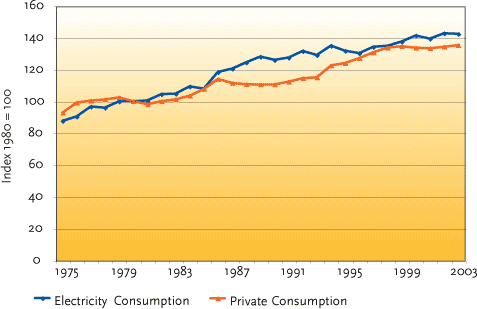
As a result of converting electric heating, total consumption by households, including heating, has been roughly constant since the late 1990s. In 2003, the domestic sector accounted for 6% of Denmark's total greenhouse gas emissions.
2.1.8 Transport
Efficient and flexible transportation of goods and persons is a vital element of the foundation of the modern welfare society. At the same time, transport is in itself an important economic sector that contributes to economic growth, employment, and foreign exchange earnings.
TABLE 2.9 TREND IN PASSENGER TRANSPORT PERFORMANCE IN BILLION PASSENGER KM
Source: Ministry of Transport, the Road Directorate and Statistics Denmark
| 1980 | 1985 | 1990 | 1995 | 2000 | 2001 | 2002 | 2003 | |
| Aircraft | 0.4 | 0.4 | 0.5 | 0.5 | 0.4 | 0.4 | 0.3 | 0.3 |
| Trains | 4.4 | 4.8 | 4.7 | 4.7 | 5.4 | 5.4 | 5.5 | 5.9 |
| Ferries | 0.5 | 0.5 | 0.6 | 0.6 | 0.2 | 0.2 | 0.2 | 0.2 |
| Cars | 38.6 | 43.2 | 50.3 | 54.0 | 59.8 | 59.3 | 60.7 | 54.8 |
| Buses | 7.3 | 8.8 | 7.6 | 9.1 | 9.1 | 9.1 | 9.0 | 8.8 |
| Total | 51.2 | 57.7 | 63.7 | 68.9 | 74.9 | 74.4 | 75.7 | 73.0 |
| Bi-cycles | 2.7 | 3.2 | 2.8 | 2.4 | 2.2 | 2.3 | 2.3 |
TABLE 2.10 TREND IN GOODS TRANSPORT PERFORMANCE, BILLION TONNE KM¹
Source: Ministry of Transport, the Road Directorate and Statistics Denmark
| 1980 | 1985 | 1990 | 1995 | 2000 | 2001 | 2002 | 2003 | |
| Freight trains | 1.1 | 1.3 | 1.2 | 1.4 | 1.2 | 1.0 | 1.0 | 1.0 |
| Freighters | 1.9 | 1.8 | 1.6 | 1.8 | 1.7 | 1.8 | 1.8 | 2.4 |
| Lorries | 7.8 | 8.3 | 9.4 | 9.3 | 11.0 | 10.9 | 11.1 | 11.0 |
| Pipelines | 0.9 | 2.9 | 4.6 | 7.1 | 7.2 | 7.6 | 7.8 | |
| Total | 10.8² | 12.3 | 15.1 | 17.1 | 21.0 | 20.9 | 21.5 | 21.8 |
¹ Goods transport by air accounts for only a small proportion of total goods transport.
² Pipelines not included.
The positive effects of the transport sector must be seen against the fact that the sector burdens society in different areas - traffic accidents, air pollution, noise, congestion, and CO2 emissions. In Denmark, this burden has been reduced in some important areas - primarily in the form of better traffic safety and less air pollution - at the same time as traffic has increased.
However, there has not been a corresponding development with respect to CO2, and the transport sector has not yet succeeded in decoupling economic growth and greenhouse gas emissions, as has been done in the energy sector. Transport performance, energy consumption and CO2 emissions within the transport sector have developed largely in step with economic growth. One reason for this is that a number of measures that have been used in other sectors, e.g. the energy sector, including efficiency improvements and substitution of energy sources, have not been directly available for the transport sector or have been associated with high costs.
The developments in passenger and goods transport performances are shown in Tables 2.9 and 2.10 respectively. In 2003, CO2 emissions by the transport sector were about 22% over the 1990 level.
In 2003 the transport sector accounted for about 22% of Denmark's total CO2 emissions.
Its contribution to Denmark's total greenhouse gas emissions are calculated as a share of the total emissions of greenhouse gases, which include industrial gases, methane, and nitrous oxide. Calculated in this way, the sector was responsible for about 18% of total emissions in 2003. The trend in CO2 emissions in the transport sector is therefore of considerable importance to the total trend in the greenhouse gas emissions.
2.1.9 The business sector
Industry's production value accounts for about 30% of total Danish production. Table 2.11 shows that the largest industries in Denmark are the food, drink and tobacco, engineering, electronics, and the chemical industry.
TABLE 2.11 TURNOVER BY INDUSTRY IN 2004, DKK MILL.
Source: Statistics Denmark.
| All industry | 522,214 |
| Mining etc. | 8,749 |
| Food, drink and tobacco | 134,233 |
| Textiles, clothing and leather | 10,280 |
| Timber/wood-working | 12,593 |
| Paper and graphic industry | 36,866 |
| Mineral oil etc. | 18,585 |
| Chemical industry | 56,504 |
| Rubber and plastics | 20,488 |
| Stone, clay and glass industry | 17,671 |
| Metal production and metal-working | 43,475 |
| Machinery | 63,254 |
| Electronics | 55,005 |
| Transport industry | 15,376 |
| Furniture industry and other industry | 29,136 |
The total business sector (industry, building and construction, together with public and private services) accounts for about 13% of Denmark's total emissions of greenhouse gases. By far the largest part of these emissions is CO2 from energy consumption, but the sector is also a source of emissions of industrial greenhouse gases.
In Denmark, the industrial sector's energy consumption accounts for about 18% of total energy consumption. This 18% does not include energy consumption for transport and space heating.
In the last 20 years relative consumption by the business sector varied considerably. Up to 1983, consumption fell considerably due to increases in the price of oil. When oil prices fell in 1986, energy consumption began rising again. In the period 1990-2003 energy consumption by the industrial sector rose by just under 5%, while electricity consumption in the same period increased by almost 15%. From 2002 to 2003 energy consumption fell by almost 1%.
FIGURE 2.11 ENERGY AND ELECTRICITY INTENSITY IN THE INDUSTRIAL SECTOR, ADJUSTED FOR INTER-ANNUAL CLIMATE FLUCTUATIONS
Source: Danish Energy Authority and Odyssee¹
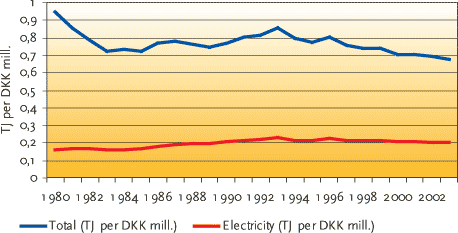
¹ ODYSSEE is a joint project between ADEME, the EIE programme of the European Commission/DGTREN and all energy efficiency agencies in the EU-15 and Norway.
Since 1994 energy and electricity intensity has fallen, see Figure 2.11.
The change in the trend in energy and electricity intensity in 1993 corresponds with change from a period of low economic growth to a period of high growth, implying better utilisation of production capacity. At the same time, from 1993 the first CO2 taxes were introduced on energy consumption by businesses, with associated subsidies for energy savings, agreement schemes etc. Advice to businesses from electricity companies was also introduced in the early 1990s.
The main action against the industrial sector's energy consumption until 2005 has been based on the green tax package for businesses passed by the Folketing in 1995. The package contained a combination of taxes and rebates to enterprises through, among other measures, government grants to promote energy savings by enterprises.
As can be seen from Figure 2.12, over the past 15 years there has been a steady increase in energy consumption by the private commerce and services sector. Primarily electricity consumption has been rising. The growth in energy consumption by the service sector is due to high growth in this sector and reflects a development where services are becoming increasingly important in the economy. As the figure shows, there has been a constant drop in intensity of on average 2.3% per year from 1975-2003. Since 1990 the drop has been on average 1.6% per year.
Energy consumption in public services (the public sector), as shown in Figure 2.12, has been roughly constant over the last 15-20 years, and since the early 1990s there has been a considerable fall in energy intensity.
For industrial greenhouse gases (HFCs, PFCs and SF6), regulation through taxes, and rules on phasing out the use of these substances have been implemented. With certain exceptions, the phasing-out process is expected to take place in the period 2003-2006.
2.1.10 Waste
The waste sector's contribution to the emissions of greenhouse gases consists primarily of methane and accounted for 2% of the total greenhouse gas emissions in 2003. Methane emissions come from the decomposition of organic waste at landfill sites and – to a minor extent
– from wastewater treatment plants. In 2003 a total of 981,000 tonnes waste were landfilled in Denmark, corresponding to 8% of the total amount of waste.
FIGURE 2.12 CHANGES IN ENERGY CONSUMPTION AND ENERGY INTENSITY (ENERGY CONSUMPTION IN RELATION TO GROSS ADDED VALUE) IN PRIVATE COMMERCE AND SERVICE AND PUBLIC SERVICE
Source: Energy Statistics 2003 Private commerce and service 140 120 100 80 60 40 20 0
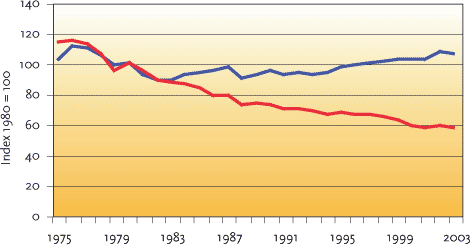
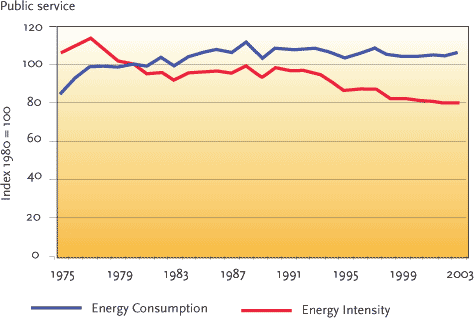
Methane emissions from the waste sector are expected to fall in the future because the municipalities are now obliged to assign all waste suitable for incineration to incineration plants. This means that only a small quantity of organic waste will be deposited at landfills compared with the quantity deposited before the introduction of this obligation in 1997.
In addition, gas from a number of landfills is being used in energy production, which contributes to a direct reduction in methane emissions and an indirect reduction in CO2 emissions.
Emissions of the industrial gases HFC and SF6 from disposal of, for example, refrigerators and certain thermal glazing, which contain these substances, are included under the business sector.
There are also CO2 emissions in connection with disposal of oil-based products, e.g. packaging, plastic bags, etc. The amount of plastic waste sent for incineration will fall with the increased recycling of plastic waste from 2008. Since waste incineration in Denmark is included in energy production, these CO2 emissions must be included under the energy sector in accordance with the inventory rules from the IPCC.
Finally, in connection with incineration, a large amount of the waste is used as an energy source. As many of the incineration plants as possible have been converted to CHP production. In other words, the heat is used to supply district heating, and the electricity is sold to electricity suppliers. In 2003, 32 incineration plants in Denmark converted 26% of the entire waste production, or 3,287,000 tonnes and contributed 3.8% of the entire Danish electricity production and 20% of all Danish production of district heating.
By recycling waste, energy (fossil fuels) is usually saved and thus emissions of greenhouse gases, in that it is often more energy-demanding to manufacture new raw materials than to recycle material in waste. However, Denmark imports most of the raw materials, therefore energy savings accrue abroad. Therefore, the reduced greenhouse gas emissions cannot be credited to the Danish CO2 accounts, even though Denmark has made the effort to increase recycling.
The government presents national action plans for the waste area for hearing by interested parties and for debate in the Folketing. These national action plans announce future state initiatives and guidelines for waste plans by the local authorities. In Denmark, the local authorities are responsible for managing all waste. Practical management is carried out by the private sector (primarily collection and recycling) or by the municipalities (primarily landfilling and incineration).
TABLE 2.12 KEY FIGURES FOR THE STOCK OF BUILDINGS IN 2004, MILL. M²
Source: Statistics Denmark
| Total building area | Buildings for year-round habitation |
Factories and workshops |
Commerce, trade and administration |
Institutions and buildings for cultural purposes |
Farm buildings |
| 670.2 | 292.3 | 55.6 | 54.8 | 39.2 | 132.4 |
2.1.11 Buildings and urban structure
One-twentieth of the area of Denmark is urbanised. 85% of Danes are town-dwellers, and most enterprises, institutions, etc., are situated in towns. Many pollution problems are therefore concentrated in the towns.
Today, the total built-up area is 670 mill. m². Table 2.12 shows the distribution of the area between housing, factories, offices, etc.
Today, about 18,000 homes are built per year, which is one-third of the number built in the first half of the 1970s. House building is expected to remain at this level. In recent years, house building has accounted for slightly more than half of all investment in building activities, and about half of the investment in the housing sector has gone on alterations and extensions. Building for industry and commerce now accounts for around half of all building in towns.
Towns and cities are generally characterised by separation of residential and industrial areas, industrial buildings being situated in specially designated zones on the outskirts of the towns. The growth in the service industries and the growth in manufacturing with a small environmental impact imply new possibilities for integrating industry and housing, thereby reducing the need for transport between home and work.
Approximately two-thirds of the total building space is heated. The most important types of heating are district heating and central heating using oil and gas. Half of the heated space is heated by district heating and, as seen from Table 2.13, the use of both district heating and natural gas has increased at the expense of oil.
TABLE 2.13 DEVELOPMENT IN THE MAIN FORMS OF HEATING IN BUILDINGS, IN % OF TOTAL HEATED SPACE
Source: Statistics Denmark.
| 1981 | 1991 | 2001 | 2002 | 2003 | 2004 | |
| District heating | 29.4 | 38.6 | 58.7 | 59.3 | 59.8 | 60.2 |
| Central heating with oil | 57.2 | 37.4 | 18.6 | 18.0 | 17.4 | 16.9 |
| Central heating with natural gas | 9 | 13.2 | 13.4 | 13.6 | 13.8 | |
| Furnaces fired by oil and similar | 2.2 | 1.5 | 1.5 | 1.4 | 1.3 | 1.2 |
| Other heating¹ | 5.8 | 5.6 | 8.0 | 7.9 | 7.9 | 7.9 |
¹ Central heating (not oil and natural gas), electric ovens and not specified
2.1.12 Agriculture
Over the last 40 years the agricultural area in Denmark has fallen from 72% (30,900 km²) of the total area in 1960 to 62% (26,578 km²) in 2003. Table 2.14 shows the breakdown by type of crop over the last 33 years.
The proportion of agricultural land under grass and greenfeed in rotation and permanent grass fell considerably from 1970 to 1990, but rose considerably during the 1990s, due partly to increasing use of grass fields for dairy farming, and partly to the change in EU subsidy schemes, which means that grass or industrial seed must be grown on set-aside land. Furthermore the area with maize and cattle feed is included with the area with grass and greenfeed, and the area with maize has increased significantly from 0.4% of the agricultural area in 1980 to 4.4% in 2003. This is due in part to a warmer climate which has made maize easier to grow.
TABLE 2.14 USE OF AGRICULTURAL LAND, LIVESTOCK, AND NITROGENOUS FERTILISER
Source: Danish Institute of Agricultural Sciences, Food and Resource Economic Institute and Statistics Denmark
| 1970 | 1980 | 1990 | 2000 | 2003 | |
| Grain (%) | 59 | 62 | 56 | 57 | 56 |
| Pulses and industrial seed (%) | 2 | 4 | 14 | 5 | 5 |
| Root crops (%) | 10 | 8 | 8 | 5 | 4 |
| Grass and greenfeed in rotation (%) | 17 | 14 | 12 | 16 | 17 |
| Permanent grass (%) | 10 | 9 | 8 | 13 | 14 |
| Other crops (%) | 2 | 3 | 2 | 4 | 4 |
| Cattle ('000) | 2,842 | 2,961 | 2,239 | 1,868 | 1,724 |
| Pigs ('000) | 8,361 | 9,957 | 9,497 | 11,921 | 12,949 |
| Sheep ('000) | 70 | 56 | 159 | 145 | 144 |
| Poultry (`000) | 19,169 | 15,507 | 16,249 | 21,830 | 17,844 |
| Nitrogen in fertilisers ('000 tonnes N) | 271 | 394 | 400 | 252 | 201 |
| Nitrogen in manure ('000 tonnes N) | - | 263 | 244 | 232 | 234 |
FIGURE 2.13 CHANGE IN ENERGY CONSUMPTION AND ENERGY INTENSITY (ENERGY CONSUMPTION IN RELATION TO GROSS ADDED VALUE) IN AGRICULTURE AND FORESTRY
Source: Energy Statistics 2003
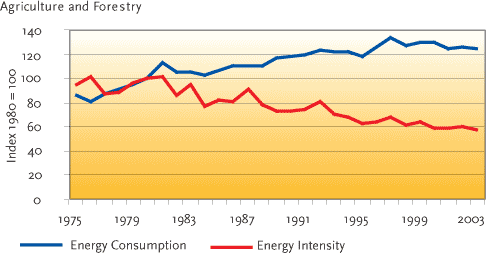
From 1980 to 2003 the number of farms fell from 119,155 to 48,613. In the same period the average size of farms increased from 24 ha to 54 ha. This development has reduced the importance of agriculture as a source of primary employment. However, in the same period agricultural production has grown, both in quantity and value, and agricultural exports still make up a large proportion - 11% - of Denmark's total exports.
During the 1990s interest in organic farming increased considerably. In 2003 organic farms accounted for approximately 6% of land under cultivation.
In the last 30 years use of nitrogen by agriculture has varied greatly, cf. Table 2.14.
Up to 1990 there was a big increase in the use of nitrogenous fertiliser, but during the 1990s use of this type of fertiliser fell considerably, and in 2003 nitrogen consumption was below the 1970 level. The nitrogen content of manure has dropped slightly since 1980. Consumption of phosphorus and potassium in fertilisers fell throughout the period.
The cattle population fell by 39% from 1970 to 2003, cf. Table 2.14. Most of the cattle are dairy cows. Since milk production remained approximately unchanged throughout the period, the fall in cattle popula-tion is due to higher productivity per animal. In the same period, the pig population increased by 55%. The sheep population has doubled in relation to 1970, while the poultry population is now roughly the same as in 1970. Since the 1970s, initiatives aimed at nutrients etc. have led to favourable trends, including with regard to greenhouse gases, where agriculture has reduced emissions by about 24% since 1990.
The agricultural sector accounted for about 17% of Denmark's total emissions of greenhouse gases in 2003. These were primarily methane and nitrous oxides. CO2 from fuel consumption in the agricultural sector accounts for about 3% of total Danish emissions.
Figure 2.13 shows the change in energy consumption and energy intensity in agriculture and forestry. Energy consumption in agriculture and forestry has increased dramatically since 1980, but since 1997 there has been a slight fall. However there has been an even greater increase in gross added value and thus a drop in energy intensity.
2.1.13 Forestry
Approximately 11% of Denmark is forested. Originally focus was mainly on the potential of conifers, but in recent years focus has changed towards indigenous, deciduous tree species as offering greater long-term production and nature potential. Denmark's forests are managed as closed canopy forests. The main objective is to ensure sustainable and multiple-use management of the forests and to manage them in line with the overall management of the countryside. Instead of clear-cut systems, forest owners are to a higher degree applying near-to-nature forest management regimes. Unlike our Scandinavian neighbours, Denmark is not a country in which forestry plays an important role in the national economy.
The Danish Forest Act protects a very large part of the existing forests against conversion to other land uses. Afforestation, for which public subsidies are made available, is as standard protected as forest reserve. In principle, this means that most of the forested land in Denmark will remain as forest.
The ambition is to have about 25% of Denmark's area forested by the end of the 21st century. A considerable increase in the forest area is therefore to be achieved.
Denmark is the only part of the Realm in which forestry is practised. Greenland and the Faroe Islands have almost no forest.
2.2 GREENLAND
2.2.1 Form of government and structure of administration
Greenland has had home rule since 1979. The Home Rule Government consists of a directly elected parliament (the Landsting), comprising 31 members. A general election is held every four years. The Landsting elects a government (the Landsstyre), which is responsible for the central administration under the Prime Minister (the Landsstyreformand). The members of the government head the various landsstyreområder (ministries).
However, since Greenland is part of the Realm, some fields of responsibility remain under the state, including the Constitution, the right to vote, eligibility for election to the Folketing, the administration of justice, the concept of citizenship, foreign policy and the National Bank.
The Home Rule Government is responsible for other areas, including transport and communication, and the environment and nature. Greenland is not a member of the EU, but has an OCT scheme (Overseas Countries and Territories scheme) that ensures the country open access to the European market for its fish products.
International agreements entered into by the Danish government also cover Greenland and apply to Greenland to the same extent unless the Home Rule Government specifically requests exemption or deviation from them. Denmark's ratification of the Climate Convention and the Kyoto Protocol both cover Greenland.
2.2.2 Population
Greenland has a population of slightly more than 56,000, 88% of which were born in Greenland.
Most of the remainder of the population comes from Denmark.
Fishing is the main industry, and it is estimated that about 2,500 people are directly employed by it. In addition, around 3,000 people work in the fisheries industry and derivative occupations.
2.2.3 Geography
With an area of 2.2 mill. km², Greenland is the world's largest island. It extends over almost 24 latitudes. Nordpynten lies only 700 km from the North Pole, and Kap Farvel, 2,600 km further south, is level with Oslo. Towards the south, the height of the sun and thus the length of day and night are almost as in Denmark. Towards the north there is the midnight sun and winter darkness, both lasting for almost two-thirds of the year.
85% of Greenland is covered by a continuous, slightly convex ice sheet, which reaches a height of more than 3,000 m above sea level. In a borehole drilled in the central part of the ice sheet, the drill reached a depth of 3,030 m into the bedrock.
The remaining 15% of the island is home to Greenland's flora and fauna, and here, on the edge of the ice sheet, the people live - mainly in the coastal areas, from which there is access to open water.
2.2.4 Climate
Greenland's northern location and the cold and more or less ice-filled seas that surround it are the main reasons for its cold climate.
Greenland has a mostly arctic climate, and forests cannot grow there. Particularly the northern part of the country is close to the North American continent, separated from it by only a relatively narrow and ice-filled sea. The position of south Greenland, on the other hand, means that the climate here is influenced by the North American continent to the west, and the ocean to the east.
Atmospheric pressure
Atmospheric pressure is generally highest in April/May. The weather in Greenland is most stable at this time of year. After this, in the summer months, the variation in atmospheric pressure is small, but in winter it is much greater, with a generally higher atmospheric pressure towards the north than towards the south, leading to a higher frequency of cold winds from northerly directions and higher wind velocities.
The biggest pressure extremes in Greenland occur in the winter period because of the great temperature contrasts in the atmosphere. The highest atmospheric pressure measured in Greenland was 1059.6 hPa, which was recorded in January 1958. The lowest was 936.2 hPa, recorded in 1986 and 1988.
Wind
Storms typically occur in connection with the passage of low-pressure systems. Between these systems, there are undisturbed periods of varying duration throughout the year, when the wind is governed by local conditions.
An example is the ice sheet's katabatic wind system, the extent of which is enormous. A katabatic wind is a wind that blows down an incline, moving from the central part out towards the edge. The wind velocity accelerates with increasing incline of the surface, and the topography can cause channelling, resulting in an extremely high velocity at the edge of the ice.
Greenland has many days with little or no wind. In some places on the east coast this is the case for 60% of the time.
Gusts can be very strong. Gusts of up to 75.1 m/s were measured in Danmarkshavn in 1975, but even stronger gusts undoubtedly occur in connection with the so-called piteraqs. These fall winds, which are katabatic, locally channelled winds from the ice sheet, occur in several locations in Greenland, and are characterised by a very abrupt change from light wind to storm. In Greenlandic, piteraq means “that which assaults one”.
Temperature
The summer temperatures on both the west and the east coast differ by only a few degrees from south to north, despite a distance of about 2,600 km. The reason for this is the summer midnight sun in north Greenland. Conversely, winter darkness and the absence of warm sea currents mean that the temperature during the winter period differs considerably from north to south. There is also a big difference in the temperature conditions at the outer coast and inside the fjords. In summer, drift ice and the cold water along the coast can mean that it is warmer inside the fjords, while in winter, on the other hand, the presence of the sea makes it warmer in the coastal areas than inside the fjords.
FIGURE 2.14 ANNUAL MEAN TEMPERATURE 1873-2004, 0C STATIONS IN DENMARK, THE FAROE ISLANDS AND WEST GREENLAND
Source: Danish Meteorological Institute
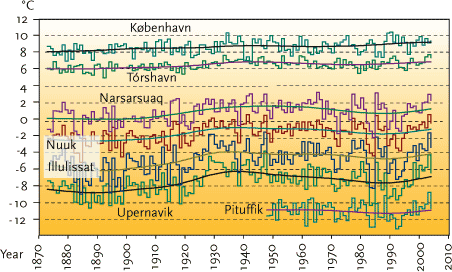
FIGURE 2.15 ANNUAL MEAN TEMPERATURE ERATURE 1873-2004, 0C STATIONS IN DENMARK, THE FAROE ISLANDS AND EAST GREENLAND
Source: Danish Meteorological Institute

Foehn winds can disturb this picture in the wintertime. Foehn winds are very common in Greenland, and in winter the hot, dry winds can cause the temperature to rise by 30°C within a relatively short space of time, resulting in melting of snow and ice. The temperature record of 13.9°C of 23 November 1987 in Nuuk is an example of the effect of a Foehn wind.
The highest temperature recorded in Greenland since 1958 is 25.5°C. It was recorded at the ice sheet station in Kangerlussuaq in July 1990.
In Greenland, frost can occur in all the months of the year except deep inside the fjords at Narsarsuaq Airport and Kangerlussuaq for a couple of the summer months. The “frostfree” period in southern Greenland varies from 60 to 115 days per year.
The coldest place in Greenland is naturally on the ice sheet, where the temperature can fall to below -70°C. Temperatures in Greenland have shown a slightly rising trend for the last 125 years, although, on a shorter time scale, temperatures have generally fallen since the 1940s. This has been most marked on the west coast, where a rising trend has only been seen over the last few years. On the east coast, however there has been a rising trend since the mid 1970s. In 2003 there were record high annual temperatures in several parts of Greenland.
Precipitation
Recorded precipitation in Greenland decreases with rising latitude and from the coast to the inland area. Particularly for southern stations there is considerable seasonal variation.
In the extreme south and particularly in the south-eastern region, precipitation is significant, average annual precipitation ranging from 800 to 2,500 mm along the coasts. Further inland, towards the ice sheet, considerably less precipitation is recorded. In the northern regions of Greenland there is very little precipitation, from around 250 mm down to 125 mm per year. In a few places there are arctic deserts, i.e. areas that are almost free of snow in winter, and where evaporation in summertime can exceed precipitation.
Not surprisingly, snow is very common in Greenland. In fact, at most stations in the coastal region it can snow all year round without snow cover necessarily forming. There are thus many days with snow during the year, mostly in the southern part of the country. The snow depth is greatest in southern Greenland, averaging from one to more than two metres in all the winter months and sometimes reaching up to six metres. In southern Greenland the snow cover can disappear altogether during the winter in connection with warm Foehn winds.
Towards the north, snow cover has already formed in most places by September and normally disappears again in June/July.
Hours of sunshine
The part of Greenland north of the Polar Circle, 66.5°N, has midnight sun and polar night of varying length depending on the latitude. Midnight sun means that the sun is in the sky 24 hours a day, while polar night means that the sun does not rise above the horizon at all.
Despite the polar night, the northern stations have more hours of sunshine than the southern stations. This is due to the “long” day, of course, but also to generally less cloud cover. However, although the surface of the soil receives more solar heat than in the tropics at around the summer solstice because of the long day, a considerable part of the energy is reflected because of the oblique angle of incidence and the snow-and-ice-covered surfaces.
2.2.5 Economy
Principal income for the Home Rule Government comes from transfers from the Danish state - the so-called block grant. In addition, the Landsstyre and the municipalities have revenue from personal and corporate taxes, indirect taxes, and licences. There is no VAT. In addition, Greenland receives payment from the EU for access by EU fishermen to Greenland's fishing waters.
Greenland uses the Danish currency, and Danish currency laws apply in connection with the transfer of funds between Greenland and other countries. This means that, in several areas, Greenland is affected by factors, e.g. interest and exchange rates that are determined by external factors.
Exports
93% of Greenland's exports of DKK 2,285 mill. in 2003 consisted of fish products, 60% of which were prawns. The export value of fish products is heavily dependent on the prices on the world market. Although there was a considerably greater production of prawns in 2003, falling prices on the world market considerably reduced the export value.
Imports
Apart from fishery and hunting products, only a few goods are made in Greenland. Imports therefore include primarily all goods used in households, businesses and institutions, and for investment. In 2003 imports amounted to DKK 3,031 mill.
2.2.6 Energy
As in other modern societies, a large part of Greenland's CO2 emissions come from energy production and supply. Approximately 55% of all energy consumption is used for heating and electricity.
Because of the big distances between towns in Greenland it is neither financially nor technically viable to establish a supply grid connecting them. This means that each town has its own power plant or CHP plant, and each settlement has its own power plant - so-called island operation. At the same time, the climatic conditions mean that the towns cannot tolerate lengthy interruptions in their electricity supply. It is therefore also necessary to have reserve and emergency plants.
Renewable energy
Up to 1993 all energy production for electricity and district heating was based on diesel-driven power, heating and CHP plants. From 1993, when the hydropower station at Buksefjord went into operation, the capital Nuuk, where around 25% of Greenland's population live, has been supplied with hydroelectricity for electric heating, lighting, and power. A small hydropower plant in east Greenland started operation in 2005, and a hydropower plant in south Greenland is currently being constructed.
Together with heat utilisation from waste incineration plants, this means that in 2001 about 8% of Greenland's energy consumption (incl. transport, industry, etc.) came from renewable energy sources.
Regular studies have been carried out with a view to utilising other renewable energy sources, but for various reasons, including the high requirements concerning security of supply, the forms of energy utilisation in question have not been of interest so far in Greenland.
Heating
Since 1993 all buildings built with public subsidies in Nuuk have been supplied with electric heating, and electric boilers with interruptible electric heating have been installed in existing district heating stations. The electric boilers operate as long as surplus electricity is available. When it is not, the oil boilers take over. The electricity for this is supplied at a competitive price. In 2002, 38% of all electricity produced in Greenland went to permanent and interruptible electric heat in Nuuk.
In 10 towns the residual heat from electricity production is used for district heating. In addition, blocks of flats have their own individual heating plant, while most single-family houses have oil-fired central heating.
In settlements, most of the houses have a central heating furnace or oil stoves.
Electricity
Electricity in Nuuk and Tasiilaq comes from hydropower stations. The electricity in the other towns and settlements is produced at diesel-driven power plants. Work is going on to optimise the utilisation of the power plants.
2.2.7 Transport
Passenger transport
All passenger transport to and from Greenland is by air, via either Copenhagen-Kangerlussuaq or Copenhagen-Narsarsuaq. From Kangerlussuaq there is a connection via east Greenland to Iceland as well as from Narsarsuaq to Reykjavik in the summer.
Between towns and settlements in Greenland, passenger transport is by passenger ship, aeroplane, or helicopter. Up through the 1990s both sea and air passenger traffic increased. The need for flexible and rapid transport between towns has increased parallel to developments in society, and this has led to an increase in the consumption of petrol.
There are bus services in the larger towns, while in the smaller ones, passenger transport is by taxi. To get out into surrounding areas people usually use sailing boats and dinghies. There are around 5,000 dinghies in Greenland. The use of private cars, which is not deemed to have much effect on Greenland's CO2 emission, is increasing. In 1990, 1,410 ordinary cars were registered by private owners, while in 2001, the figure rose to 2,097 - a 50% increase.
Goods transport
Almost all goods transport, both to and within Greenland, is by sea. A small proportion, mainly mail and perishable goods, is transported by air. Increased coordination of passenger and goods transport by sea is being considered at regional level. Efficient and flexible transport of goods and passengers contributes to economic growth, increased employment, and foreign-exchange earnings. Therefore this is essential for developing society.
2.2.8 Industry
The principal industry in Greenland is fishing/fisheries, both with regard to export revenues and employment. In 2001 the fishing fleet and the land-based production facilities for fish, crabs and prawns accounted for about 30% of Greenland's entire energy consumption. Consumption is based mainly on fossil fuels (diesel oil, petrol and benzene). The industry is very sensitive to market fluctuations and it is therefore difficult to predict how it will develop.
TABLE 2.15. INCREASE IN HOUSING 1999-2003, BY MUNICIPALITY
Source: Statistics Greenland
| Total | 1999 | 2000 | 2001 | 2002 | 2003 | |
| Total | 930 | 191 | 83 | 239 | 185 | 232 |
| Nanortalik | 35 | 9 | 2 | 19 | 2 | 3 |
| Qaqortoq | 43 | 4 | 4 | 16 | - | 19 |
| Narsaq | 30 | 22 | 1 | 2 | 1 | 4 |
| Paaamiut | - | - | - | - | - | - |
| Nuuk | 376 | 6 | 4 | 144 | 122 | 100 |
| Maniitsoq | 45 | 25 | 2 | 14 | 2 | 2 |
| Sisimiut | 140 | 55 | 37 | 3 | 11 | 34 |
| Kangaatsiaq | 13 | - | - | 1 | 3 | 9 |
| Aasiaat | 41 | 16 | 8 | - | 12 | 5 |
| Qasigiannguit | 2 | - | - | - | - | 22 |
| Ilulissat | 77 | 11 | 12 | 19 | 14 | 21 |
| Qeqertarsuaq | 14 | 8 | 5 | - | 1 | - |
| Uummannaq | 30 | 10 | 1 | 2 | 12 | 5 |
| Upernavik | 38 | 17 | - | 9 | 2 | 10 |
| Qaanaaq | 13 | 3 | 6 | 2 | - | 2 |
| Ammassalik | 29 | 5 | 1 | 4 | 3 | 16 |
| Illoqqortoormiut | 4 | - | - | 4 | - | - |
A large part of the rest of trade and industry consists of service enterprises. Except for electricity and district heating, energy consumption and CO2 emissions are not calculated separately for this part.
Exploration for raw materials (oil and minerals) is being carried out in Greenland continuously. If large-scale extraction and production are started up at some time in the future, this could have a dramatic effect on Greenland's CO2 emissions.
There do not appear to be any enterprises using industrial gases in their production. Small amounts of potent greenhouse gases are used in refrigeration. In recent years these have been phased out on a voluntary basis.
2.2.9 Waste
Approximately 30,000 tonnes of waste are produced in Greenland each year. Six incineration plants in towns incinerate about 70% of the waste, while 47 small incineration plants in settlements together incinerate 13%. Much of the residual heat from the six incineration plants in towns is used for district heating. The possibilities for reducing the quantity of waste sent to landfills/ burnt are being investigated.
2.2.10 Buildings and infrastructure
As at 1 January 2004 there was a total of 20,928 dwellings in Greenland with an area of 1,379,633 m². The average dwelling is 63.8 m²and this figure is rising. Most dwellings are situated in the few large towns.
About 200 new dwellings per year are being built. However, as can be seen from Table 2.5 below, the increase in dwellings fluctuates considerably from year to year.
The public sector plays a very important role in the housing sector. Most housing is government housing or built with a government grant. Grants are available for housing built by the owners themselves, cooperative housing, private housing, as well as municipal rental housing. The public sector also subsidises renovation and improvements to private dwellings. For example insulation and replacement windows are initiatives which will lead to reductions in energy consumption by the dwelling. A large proportion of the houses are more than 15 years old, and a refurbishment programme has been initiated. This modernisation includes reducing the energy consumption of individual houses.
2.2.11 Agriculture
Geographically, Greenland's agriculture is placed in the south and has a very limited impact on CO2 emissions. It consists mainly of sheep farming, as can be seen from Table 2.16. In Greenland in 2003 there was a total of 59 livestock herds, with 57 sheep herds and 2 herds of domestic reindeer. The number of sheep has remained relatively constant since 1990, whereas the number of domesticated reindeer has more than halved. Since 1990 the area farmed has grown by 89%. The increase in the area farmed is due to cultivation of a large quantity of coarse fodder.
TABLE 2.16. AGRICULTURAL AREA AND NUMBER OF SHEEP AND DOMESTIC REINDEER IN GREENLAND, 1990 AND 2003
Source: Statistics Greenland, Home Rule Government, and Nunalerinermut Siunnersorteqarfik/consultancy service for agriculture
| 1990 | 2003 | |
| Agricultural area (ha) | 460 | 870 |
| Sheep (total) | 19,929 | 19,242 |
| Domestic reindeer (total) | 6,000 | 3,100 |
2.2.12 Forestry
There is no forestry in Greenland apart from four experimental plantations with conifers, with a total area of 130 ha.
2.3 THE FAROE ISLANDS
2.3.1 Form of government and structure of administration
The Faroe Islands have home rule status, and their internal affairs are governed by the Faroese parliament (the Lagting). The Faroe Islands are not a member of the EU.
International agreements entered into by the Danish government cover the Faroe Islands and apply to them to the same extent, unless the Faroese government specifically requests exemption or deviation from them.
Denmark's ratification of the Climate Convention covers the Faroe Islands as well, but at the request of the Faroese government, geographical exemption was taken for the Faroe Islands in connection with Denmark's ratification of the Kyoto Protocol.
2.3.2 Population
In 2003 the Faroe Islands had a population of 48,214 - an increase of 6,000 since 1977. Net immigration was relatively small up to the beginning of the 1980s but increased relatively sharply in the years 198489 as a consequence of a high level of economic and employment activity. In the years 1990-1995 this picture changed to extensive emigration due to a serious deterioration in the economic and employment situation. In 1993 and 1994 alone, net emigration corresponded to 8% of the total population. Since 1996, the population has been growing. In 2003 the capital, Thorshavn, had a population of 18,684, corresponding to slightly less than 40% of the entire population.
2.3.3 Geography
The Faroe Islands consist of 18 small, mountainous islands situated in the North Atlantic at about 62oN and 7oW. The islands extend over 113 km from north to south and 75 km from east to west, and the total area is 1,399 square kilometres. The highest points, almost 890 metres above sea level, are on the northern islands. 17 of the islands are inhabited.
2.3.4 Climate
The climate on the Faroe Islands is strongly affected by the warm North Atlantic current and frequent passage of cyclones, which, depending on the location of the polar front, mainly come from southwest and west. The climate is characterised by mild winters and cool summers and the weather is often moist and rainy.
The high pressure over the Azores sometimes shifts towards the Faroe Islands. This can result in stable summer weather lasting several weeks, with quite high temperatures. In winter, on the other hand, the low pressure systems can move more southerly around the islands than normal, bringing in cold air from the north and a lengthy period of sunny winter weather.
The maritime climate is also a result of the cold east Iceland current (polar current), which splits into two currents from eastern Iceland towards the Faroe Islands. The mixing of the water masses from this and the warm Gulf Stream causes a relatively big difference in the sea temperatures around the islands, and this in turn causes local variations in the climate.
Atmospheric pressure
The normal atmospheric pressure at sea level in Thorshavn is 1008 hPa on an annual basis, lowest from October to January (1004-1005 hPa) and highest in May (1014 hPa). The lowest atmospheric pressure recorded was 930.3 hPa on 11 January 1993, and the highest was 1048.9 hPa recorded on 13 December 1995. The islands have long periods with both low pressure and high pressure.
The Faroe Islands lie close to the normal cyclone paths over the North Atlantic, and big and frequent changes in atmospheric pressure, with rises and falls of 20 hPa within 24 hours are common throughout the year. Sometimes, however, such violent cyclones develop that pressure falls of more than 80 hPA/24 hours occur.
Temperature
The annual mean temperature in Thorshavn is 6.5°C. The temperature in January and February is around 3.5°C, and in July and August, around 10.5°C. The annual mean temperature varies from place to place and is lowest at Vága Floghavn, 6.0°C, and highest in Sandur on the island of Sandoy, 7.0°C.
In the 1990s the temperatures in Thorshavn exhibited a slightly rising trend.
Precipitation
Annual precipitation in Thorshavn is 1284 mm, most in autumn and least in summer. There are big geographical variations in precipitation, mainly due to the topography of the islands.
It rains a lot on the Faroe Islands. Indeed, the Hvalvík has as much as 300 days with precipitation, and Thorshavn, 273 days. In the winter, precipitation is often in the form of snow. On average, Thorshavn has 44 days of snowfall per year, mostly in December and January. There is no snow at all in June, July, and August, but there can be snow in September.
Since the mid 1970s, precipitation in Thorshavn has been roughly stable.
Hours of sunshine, cloud cover and relative humidity
Thorshavn has 840 hours of sunshine per year, most in May and June, the average being around 125 hours. In some Decembers there are no hours of sunshine at all. The highest number of hours of sunshine in a calendar month was 232 hours, observed in May 1948 and in May 2000.
The location in the North Atlantic, combined with frequent low-pressure fronts, results in a large number of cloudy days (>80% cloud cover) - 221 days in Thorshavn.
The number of hours of sunshine in Thorshavn has remained stable for the last 20 years, but with a slightly increasing trend in the most recent part of the period.
The Faroe Islands have a moist climate, and the relative humidity is very high, 88% on an annual basis in Thorshavn. It is highest around August, and this is also when most fog occurs.
Wind
The mean wind is generally high on the Faroe Islands, particularly in autumn and winter (6-10 m/s). The wind is normally lightest in summer (4.5-6 m/s). There are normally no storms from April to August, while autumn and winter are windy, with many storms, some of which can reach hurricane force.
The highest 10-minute mean winds are about 50 m/s, recorded at Mykines Lighthouse in March 1997 and January 1999. In 1997, gusts of almost 67 m/s were recorded at Mykines Lighthouse.
Although the weather is generally windy, there are also still periods, mostly in summer and mostly of short duration.
2.3.5 Economy
The rapid growth in the Faroese economy since 1995 reversed in 2003. The balance of trade for 2003 shows a deficit of DKK 733 mill. Compared with a surplus of DKK 339 mill. in 2002, a drop of DKK 1,072 mill. in just one year
TABLE 2.17 GROSS NATIONAL PRODUCT AT FACTOR COST 1998 -2002, BREAKDOWN BY SECTOR
Source: The Office of the Danish Chief Administrator in the Faroe Islands (2004)
| 1998 | 1999 | 2000 | 2001 | 2002 | |
| DKK mill. | |||||
| Non-financial companies | 3,960 | 4,399 | 4,703 | 5,378 | 5,580 |
| Financial companies | 320 | 301 | 380 | 358 | 357 |
| Public administration and service | 1,322 | 1,417 | 1,535 | 1,697 | 1,866 |
| Domestic and NPISH¹ | 990 | 1,089 | 1,198 | 1,477 | 1,563 |
| Indirect measured financial services | -334 | -350 | -383 | -356 | -361 |
| Total | 6,258 | 6,856 | 7,433 | 8,554 | 9,005 |
¹ NPISH: Non-profit institutions for households, Source: Hagstova Føroya
About 80% of exports from the Faroe Islands go to EU countries. Of this, Denmark accounts for 25% and the UK slightly less. In 2002 the Faroe Islands' GDP was DKK 10.2 billion.
In the last few years, the Faroe Islands have turned a net foreign debt into a net credit balance, although with a big difference between the private and the public sector. At the end of 2001 the private sector had a net credit balance of more than DKK 6 billion, while the public sector's net foreign debt stood at DKK
1.9 billion. Unemployment has fallen sharply in the last few years and in 2003 was around 3%, although it rose to 4% in mid 2004 as a result of less favourable economic trends. Table 2.17 shows the development and breakdown by trade and industry, measured in gross national product at factor cost.
The surplus on the balance of payments, which, besides the balance of trade, includes services, wages, interest, transfers from the Danish state and “Danmarks National bank”, fell in 2002 by about DKK 200 mill. compared with 2001. One explanation is less transfers from abroad as a result of the reduction in the block grant from 1 January 2002. The balance of payments is expected to be much worse in 2003 as a result of the trend in the balance of trade.
The Faroe Islands use the Danish currency and are part of the Danish currency area, although they have their own notes.
2.3.6 Energy
The joint municipal company SEV is responsible for the production and sale of electricity on the Faroe Islands. In 2003 production amounted to about 249 mill. kWh cf. Table
2.18. Of this, about 34% was based on hydroelectricity, while the remainder was produced at diesel-driven plants. There is not much electricity production based on wind power - only 1.2% or 3 mill. KWh in 2003. There are currently plans to expand wind energy to a total of about 4 MW, at the same time annual production from wind energy is expected to reach about 9.8 mill. kWh.
Sales of electricity in 2003 were distributed between 31% for domestic users, 34% for industry, agriculture and fisheries, and 13% for the service sector, with the remainder for street lighting etc.
Since a number of oil finds in British territorial waters close to the Faroese border in the 1990s, there has been a reasonable presumption that there is oil in Faroese territory, and the first licensing round was held in the spring of 2000. The first licences for exploration and production of hydrocarbons in the subsoil off the Faroe Islands were granted in August 2000. The first three exploration wells were drilled in 2001, and a further well in 2003. In one of these, oil and gas were found. An evaluation programme is now being carried out to determine whether this find is commercially viable.
TABLE 2.18 ELECTRICITY PRODUCTION 1999-2003 (GWH)
Source: The Office of the Danish Chief Administrator in the Faroe Islands (2004)
| 1999 | 2000 | 2001 | 2002 | 2003 | |
| Hydropower | 70.2 | 76.0 | 76.0 | 95.9 | 85.7 |
| Diesel power | 130.6 | 136.4 | 154.8 | 143.2 | 160.3 |
| Wind power | 0.6 | 0.5 | 0.5 | 0.6 | 3.0 |
| Total | 201.4 | 212.9 | 231.3 | 239.7 | 249.0 |
2.3.7 Transport
Goods transport between the Faroe Islands and the rest of the world is mainly by sea. Two Faroese shipping companies operate freighter services all year round. Since 1998, the Smyril Line has carried freight in connection with their passenger winter sailings to Denmark. The Icelandic company EMISKIP also operates freight services throughout the year and has an office on the Faroe Islands.
Besides Vágar Floghavn, the Faroe Islands have 12 helicopter pads. Air services are provided by MAERSK AIR, ICELAND AIR and the Faroese company ATLANTIC AIRWAYS. The number of air travellers to and from the Faroe Islands has risen sharply in the last few years.
Passenger transport by sea takes place mainly in the summer period. There are both regular services (Smyril Line) and cruise liners. The number of foreign passenger ships calling at the Faroe Islands has been increasing in recent years.
For 20-30 years up to the beginning of the 1990s and again over the last few years, major investments have been made in enlarging and modernising the transport infrastructure on the islands and the communication links with the outside world. Constructing roads, tunnels, and harbours is costly because of the difficult topographical conditions. Since an economic downturn at the beginning of the 1990s, the number of motor vehicles has increased by almost 1,000 per year since 1995 and in 2003 there were 23,220 motor vehicles, of which about 17,000 were cars and 3,900 lorries and vans.
2.3.8 Industry
Excluding exports of ships, which vary considerably over the years, 98% of the Faroe Islands' export earnings come from fish and fish products. The fishing industry is therefore of vital importance to earnings and employment on the Faroe Islands. The limited opportunities in other sectors of industry reinforce still further the totally dominant role of the fishing industry. Small villages in particular are almost entirely dependent on fisheries. In 2001 more than 27% of total wages on the Faroe Islands came from the fishing industry. Today, the number of man-years in the fishing fleet itself is estimated to be about 2,000.
Besides the actual fish industry, a number of workshops and industrial enterprises have been built up to make equipment etc. for fishing vessels and the fisheries industry. This group includes shipyards and firms making fishing tackle, and machines and equipment for filleting factories.
The absence of a large domestic market, high transport costs for raw materials and finished goods, and - in an international context - a relatively high level of overall costs have hitherto prevented the Faroe Islands from establishing export-oriented industries apart from the fishing industry and the firms supplying it.
To a certain extent, the Faroese government grants loans to small businesses – particularly in outlying areas. Finally, the government has provided widespread guarantees for loans to businesses.
2.3.9 Buildings and urban structure
For many years, the Faroese authorities have made every effort to counteract migration from the small or isolated villages and islands, in particular through a major road-building programme and other transport measures. However, population development is generally poorer in these outlying areas than in other parts of the country.
Housing is predominantly single-family houses, most of which are relatively large and of high standard.
2.3.10 Agriculture
Until the end of the nineteenth century, farming was the Faroe Islands' main industry, but with the economic and industrial development since then, particularly within fisheries, farming today accounts for only 0.3% of the Faroe Islands' gross national income at factor cost.
With a view to increasing the self-sufficiency of the Faroe Islands, the government is providing grants for investments in farming.
With about 5% of the land under cultivation, the Faroe Islands can supply just over half of its total demand for lamb and mutton, most of its demand of milk, half of the demand for potatoes, quarter of the demand for eggs, and a small fraction of demand for beef. In 2003 the Faroe Islands had about 1,200 dairy cows and about 70,000 sheep.
2.3.11 Forestry
There is no commercial forestry on the Faroe Islands, but there are a number of plantations on the islands, which are maintained by the Faroese forestry authority.
Version 1.0 December 2005, © Danish Environmental Protection Agency